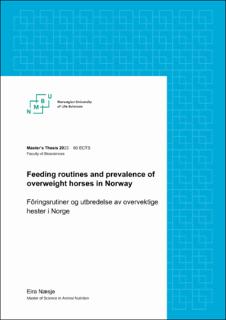| dc.description.abstract | Background: Over the latest years feeding recommendations for horses have changed continuously. The minimum recommendations for forage intake have increased, and ad libitum feeding is encouraged to ensure welfare and health of horses. However, a higher forage intake might result in higher energy intake for the horse. When body condition scoring horses, the prevalence of obesity ranges from 21 to 62% in Scandinavia, Great Britain and the USA. Obesity in horses may lead to health problems and supress animal welfare. Little is known about the body condition score (BCS) of horses in Norway, feeding routines and the percentage of imported horse feeds in Norway.
Aim: The aim of this study was to investigate feeding routines and the prevalence of overweight horses (BCS>6) in Norway.
Materials and methods: In this thesis, a cross-sectional study of 424 horses was conducted. The horses were body condition scored (Kohnke, 1992) and body weight was measured on a weight scale (n=398/424). The horses (n=424) consisted of 144 horses studied at the Equine Hospital at NMBU and 280 horses at private stables in the field. Information about the horses’ gender, age, breed, use, and health status was collected. The total number of horses studied consisted of 219 geldings, 158 mares and 37 stallions, with ages ranging from 6 months to 29 years. In addition, 266 out of the 424 horses’ and 18 owners of horses who was not body condition scored answered a questionnaire about feeding routines of their horses.
Results: Ninety percent of the horses in the present study were fed Norwegian produced forage. Horses fed imported forage had a lower BCS than horses fed self-produced forage, and 90% of horses fed imported forage were competition trotters. In addition to forage, 68% of the horses were fed concentrate from Norwegian manufacturers only. The origin of concentrate did not affect the BCS, neither the type of forage fed. The prevalence of overweight horses in Norway, with a BCS over 6, was 47%. There were no underweight horses (BCS under 4) in the present study. Gender, age, breed, activity, health, and use affected the horses BCS. Horses with teeth or jaw injuries had the biggest effect on BCS, followed by the horses’ breed.
Conclusion: In conclusion, most of the horse feed in Norway is Norwegian produced or from Norwegian manufacturers, and the prevalence of overweight horses investigated in the present study was 47%. | |
